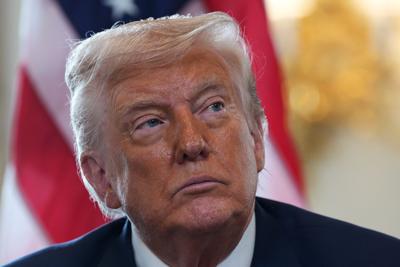OTTAWA — With trade talks lumbering on, and questions about what type of deal Canada might get with Donald Trump after the European Union agreed to keep American tariffs, Stephen Harper believes an attitude is taking root in the United States. And he thinks it’s wrong.Â
On stage at a Canada-U.S. relations conference in Saskatoon on Monday, the former Conservative leader described himself as possibly the most pro-American prime minister in Canadian history. But even he believes the breach of trust that comes from Trump’s pursuit of “comprehensive protectionism” — which Harper defined as a “failed economic policy” designed to wrest economic prowess from other countries through tariffs — means Canada must stop relying so heavily on the U.S., in both commercial and military terms.Â
It’s the opposite advice he would have given the federal government a year ago, Harper said, but true to what he told Prime Minister Mark Carney’s administration when it asked for his views in recent weeks.Â
And part of it has to do with this new American attitude, as exemplified in Trump’s declaration of trade war against essentially the entire world, Canada included, Harper said.Â
“There is a view taking hold in the present American administration that … sort of sees the world as everybody needs America but America doesn’t need anybody, and I’ve got to tell you that isn’t true,” Harper said.Â
“The reality now that we have not faced as a country in 100 years, of seeing the United States flex its muscles in a way that has nothing to do with values or ideals, that is something we can’t forget, and we cannot make ourselves entirely dependent on that relationship.”
Harper’s comments come as Canada’s trade war with the U.S. approaches its latest date of potential consequence. Trump has threatened to increase tariffs on at least some Canadian imports from 25 per cent to 35 per cent on Aug. 1 — this coming Friday — if the ongoing negotiations with Canada fail to result in a new deal. Dominic LeBlanc, the federal cabinet minister leading trade talks with the U.S., is set to return to Washington before the deadline, after he went there for the latest round of talks last week, his office confirmed.
Canada and other countries around the world are watching to see if U.S. President Donald Trump follows through on his threat to increase tariffs on most nations this week. Here is a look at how Trump's trade war has unfolded with Canada so far. (July 27, 2025)
Speaking Monday in Prince Edward Island, Carney said negotiations with the U.S. are “at an intense phase,” but repeated that his government won’t agree to anything that’s not a “good deal” for Canada.
“There is a landing zone that’s possible, but we have to get there, and we’ll see,” Carney said. He added in French that Canada is not likely to land a deal that removes all American tariffs, noting in particular those that the U.S. justifies for national security reasons.Â
He said it’s now a question of the level and breadth of such tariffs that might remain under any deal.Â
The question of which tariffs might remain was fresh in the minds of many observers Monday, after the European Union struck a deal with the Trump administration over the weekend.
That deal, announced at a meeting in Scotland, saw the EU agree to a 15-per-cent tariff in a deal that kept import duties of 50 per cent on steel and aluminum. Days earlier, Japan also agreed to a 15-per-cent tariff on most exports into the U.S., and similarly kept the steel and aluminum duty at 50 per cent.Â
That steeper tariff is among those — alongside tariffs on lumber and threatened duties on copper, pharmaceuticals and some other goods — that the U.S. has argued are necessary for its national security. And it’s nightmare fuel for Catherine Cobden, president and chief executive officer of the Canadian Steel Producers Association. Canadian steel and aluminum producers are already hobbling under the impact of their own 50-per-cent American tariff, which Cobden said has decreased production of steel in this country by 30 per cent and caused at least 1,000 layoffs. Cobden said her sector will see any Canada-U.S. deal that lands this week as a failure if it leaves the 50-per-cent tariff in place.Â
“We can’t settle for a 50-per-cent tariff — full stop,” she said. “That will be an unacceptable outcome for us.”Â
Codben said that if a deal is not struck this week, the federal government should revert to slapping counter-tariffs on American imports to match those on steel and aluminum. So far, Carney’s government has refrained from doing so after Trump raised the steel and aluminum tariff last month, as Ottawa pursues a deal to reduce the layers of tariffs that Trump has imposed since returning to office in January, including on goods that don’t comply with 2018’s Canada-United States-Mexico Agreement (CUSMA), and on auto exports to the U.S.Â
For some, the Japan and EU deals shouldn’t be taken as a sure indication of what is to come in any U.S. trade deal with Canada. Flavio Volpe, president of the Automotive Parts Manufacturers’ Association, said Europe and Japan are the U.S.‘s competition on auto manufacturing, while Canada’s automotive sector is deeply integrated with production south of the border. Arguing any auto tariff higher than zero is unacceptable for Canada, Volpe noted that the federal government has matched American policies to tariff Chinese-made electric vehicles, and taken measures alongside Washington to address concerns about the dumping of cheap steel in North America.Â
“We are not in any way the same as the EU and Japan. We are a partner, and we also show that partnership by sticking our chins out on China,” Volpe said.Â
Goldy Hyder, president of the Business Council of Canada, agreed the situations are different. The EU, for instance, had to “buy down” the tariff by agreeing to purchase more American energy and direct investment there, while Canada already has broad access to the U.S. market through CUSMA, Hyder said. With the Trump administration insisting on keeping some tariffs, Hyder said the goal should be to strike a deal with duties as low as possible, while preserving the remaining free trade for billions of dollars of goods that flow tariff-free under CUSMA.Â
“We’re no longer in a world where free trade means no tariffs,” Hyder said.Â
Matthew Holmes, chief of public policy at the Canadian Chamber of Commerce, added that Canada has some advantages in trade talks that other countries don’t, including the fact that Canada is “the largest buyer” of American exports, with almost $480 billion worth in 2024, according to . Combined with integrated supply chains for manufacturing cars, producing beef, and ties in other sectors, the access through CUSMA means Canada would remain in a good position even if overall tariffs go up between the U.S. and other countries — and especially if any tariffs that remain on Canadian goods are lower.Â
“In the short term, the disruption is real, the cost is real,” he said. “But in the longer term, this really becomes about preserving and protecting as much of the CUSMA relationship as we can, because that will be the difference-maker for us.”Â
Error! Sorry, there was an error processing your request.
There was a problem with the recaptcha. Please try again.
You may unsubscribe at any time. By signing up, you agree to our and . This site is protected by reCAPTCHA and the Google and apply.
Want more of the latest from us? Sign up for more at our newsletter page.































To join the conversation set a first and last name in your user profile.
Sign in or register for free to join the Conversation